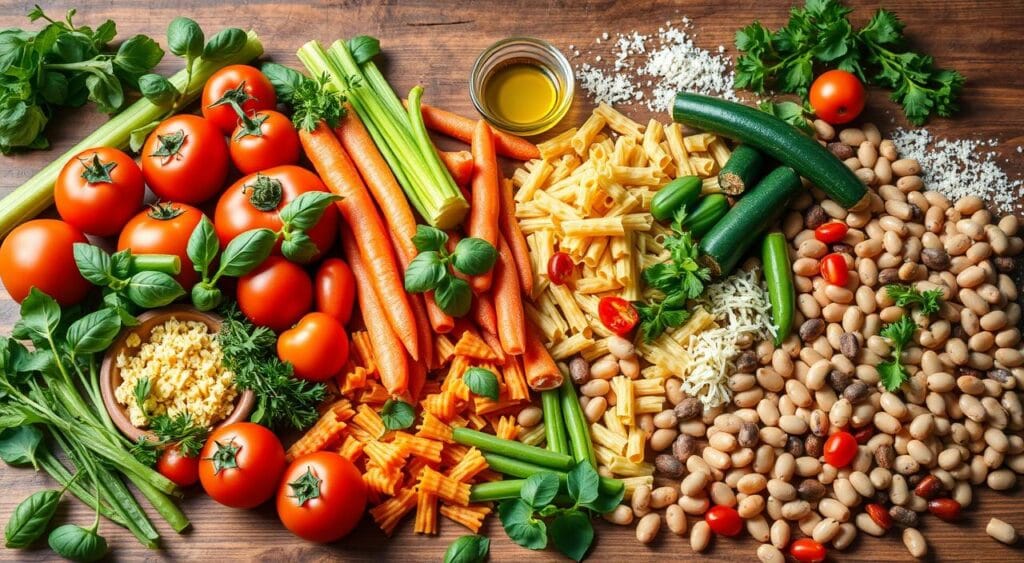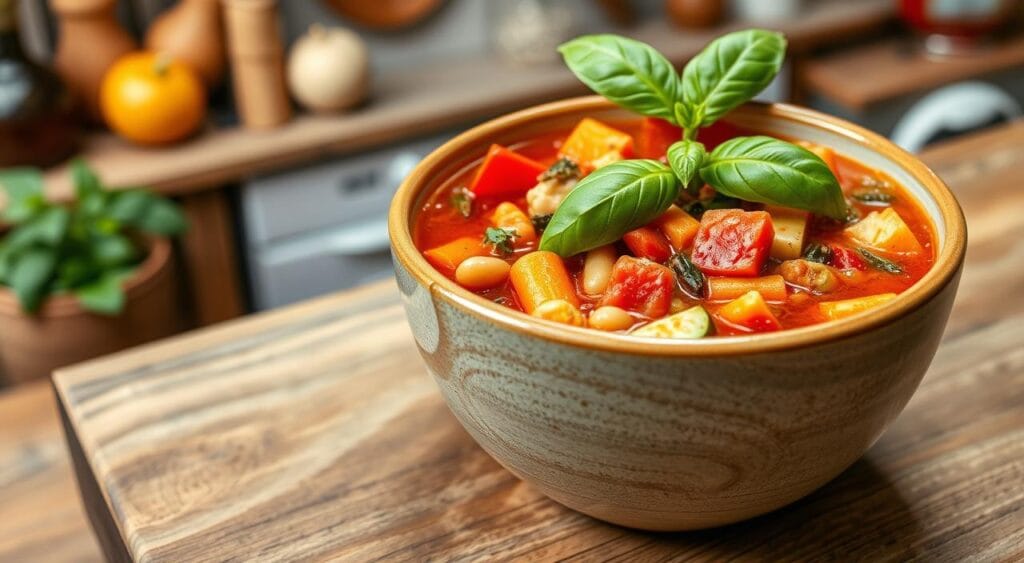As the aroma of simmering vegetables and herbs fills the air, I’m instantly transported back to my childhood in Italy. There, a steaming bowl of authentic italian minestrone soup recipe was a cherished family tradition. The rich, nourishing broth and the blend of seasonal produce and pasta or beans have become a beloved staple in homes across Italy and around the world.
This classic Italian minestrone recipe offers a comforting taste of the old country. It reminds us of the importance of preserving the culinary heritage that has been passed down through generations.
Key Takeaways
- Discover the rich history and regional variations of traditional Italian minestrone soup.
- Learn how to select the perfect seasonal vegetables and ingredients for an authentic minestrone.
- Understand the key herbs, seasonings, and cooking techniques that define the classic Italian minestrone flavor.
- Explore serving suggestions and storage tips to enjoy the perfect homemade minestrone soup.
- Appreciate the importance of preserving the culinary heritage of this beloved Italian dish.
Understanding the Heritage of Classic Italian Minestrone
The minestrone recipe has deep roots in Italy’s culinary history. It started as a simple Italian peasant soup and grew into a favorite dish. This vegetable-based soup shows Italy’s creativity and diversity, with each region adding its own twist.
Regional Variations Across Italy
Minestrone’s core ingredients stay the same, but how it’s made changes a lot by region. In the north, it often includes potatoes and turnips. In the south, tomatoes, eggplant, and zucchini are more common. Tuscany adds rosemary and sage, while Liguria uses pesto for a unique taste.
Historical Significance in Italian Cuisine
The traditional minestrone recipe is a big part of Italian food history. It was made to use up leftover veggies and scraps. This shows the cleverness of Italian cooks. Now, it’s a symbol of Italy’s diverse culture, with each area adding its own touch.
“Minestrone is the ultimate expression of the Italian peasant spirit, where simplicity and creativity converge to create a truly nourishing and delicious dish.”
Today, the traditional minestrone recipe is still loved by many in Italy. It reminds them of the country’s rich food history and the joy of homemade cooking.
Essential Ingredients for Authentic Italian Minestrone Soup Recipe
Making a real Italian vegetable minestrone soup needs careful picking of fresh, seasonal stuff. At its core, a mix of vegetables adds different tastes and textures. Tomatoes, beans, greens, and pasta all matter for the soup’s true Italian flavor.
To get the real taste of Italy in your minestrone, use these key ingredients:
- Fresh seasonal veggies like onions, carrots, celery, zucchini, and spinach or kale
- Hearty beans like kidney, cannellini, or garbanzo for protein and bulk
- Small pasta shapes like ditalini, elbow macaroni, or small shells for texture
- Aromatic herbs like fresh basil, oregano, and parsley for a Mediterranean taste
- Good extra-virgin olive oil for sautéing and a silky feel
- Rich vegetable or chicken broth for the soup’s savory base
Choosing and mixing these key ingredients well lets you make a genuine Italian vegetable minestrone soup. It’s a true taste of home-cooked comfort.
“The secret to a delicious minestrone soup is in the quality and variety of the vegetables used. Each ingredient contributes its own unique flavor and texture to create a harmonious and satisfying dish.”
Minestrone is all about trying new things with the seasons and what you like. By focusing on these key parts, your homemade hearty minestrone soup will taste like Italy in every bite.
Seasonal Vegetable Selection Guide for Perfect Minestrone
To make a delicious seasonal vegetable minestrone, pick your veggies with the season in mind. This ensures they’re at their freshest and tastiest. It also highlights the variety of Italian produce all year round.
Spring and Summer Vegetables
In the warmer months, your Tuscan minestrone can really come alive. Use tender greens like spinach, kale, or Swiss chard. Add fresh peas, zucchini, and eggplant for extra flavor.
Tomatoes, both fresh and canned, add a nice tanginess to the soup.
Fall and Winter Produce Options
When it gets cooler, root veggies and winter squashes are perfect. Make a hearty minestrone with potatoes, carrots, parsnips, and butternut squash. Cabbage and kale add a rich, earthy taste.
Year-round Staple Ingredients
Some ingredients are great in minestrone all year. Onions, celery, and garlic create a fragrant base. Canned beans like kidney or cannellini add protein. Pasta, whether small or large, adds texture and warmth.
Choosing the right veggies for the season makes a seasonal vegetable minestrone truly special. It showcases the best of Italian produce. Serve it with a high-protein crock pot recipe for a full and satisfying meal.
Choosing the Right Pasta and Beans for Your Soup
When making a classic Italian minestrone soup, picking the right pasta and beans is key. Traditional Italian minestrone recipes use small pasta shapes. These shapes blend well with the soup’s vegetable broth.
Popular pasta choices for an authentic Italian minestrone soup recipe are:
- Ditalini: These small, thimble-shaped pasta pieces add a delightful chewiness to the soup.
- Tubetti: These short, tube-like pasta shapes provide a satisfying texture and ensure each bite contains a harmonious blend of ingredients.
- Acini de pepe: These tiny, peppercorn-like pasta beads create a delicate and cohesive mouthfeel.
Choosing the right beans is also important in classic Italian minestrone recipes. Common bean choices include:
- Cannellini beans: These creamy, white beans offer a rich, substantial texture to the soup.
- Kidney beans: Their firm yet tender bite and distinct flavor complement the medley of vegetables.
- Borlotti beans: Also known as cranberry beans, these offer a slightly nutty taste and soft, creamy consistency.
Try mixing different pasta shapes and bean varieties to find your perfect authentic Italian minestrone taste.

Traditional Herbs and Seasonings in Minestrone
Creating the perfect traditional minestrone recipe starts with herbs and seasonings. Basil, oregano, and rosemary add a rich flavor. They make the Tuscan minestrone taste like Italy.
Fresh vs. Dried Herb Usage
Fresh herbs bring a lively taste to Italian dishes. But dried herbs are handy when fresh ones are hard to find. The best mix is using both for a balanced flavor.
Regional Seasoning Variations
- In northern Italy, garlic, rosemary, and fennel seeds give minestrone a unique taste.
- Central and southern Italy use lots of basil, oregano, and a bit of red pepper for heat.
- Coastal areas like Liguria add pesto or Parmesan cheese for extra flavor.
Trying different seasonings lets you experience Italy’s rich food culture. Your homemade minestrone will show off Italy’s culinary traditions.
Step-by-Step Cooking Instructions
Making a traditional authentic Italian minestrone soup recipe is easy. It lets you enjoy the rich tastes of this hearty dish. Follow these steps to make a delicious minestrone soup at home:
- Begin by sautéing the aromatic vegetables. In a big pot or Dutch oven, heat a tablespoon of olive oil over medium heat. Add diced onions, carrots, and celery, and sauté until they’re soft and smell great.
- Then, add the garlic and sauté for another minute, making sure it doesn’t burn.
- Next, pour in your chosen vegetable or chicken broth. Bring the mix to a gentle simmer.
- Add canned tomatoes, diced potatoes, and other veggies like zucchini, green beans, or spinach. Season with salt, pepper, and your favorite Italian herbs.
- Let the soup simmer for 20-30 minutes. This lets the veggies get tender and the flavors mix well.
- In the last 10 minutes, add cooked pasta or beans. This makes sure they heat up properly.
- Before serving, taste the soup and adjust the seasoning. Add more salt, pepper, or herbs if needed.
By following these easy steps, you can make a hearty minestrone soup that’s true to Italian tradition. Serve it hot, topped with Parmesan cheese and parsley. It’s a comforting and satisfying meal. Enjoy your homemade authentic Italian minestrone soup!

“The secret to a great minestrone is in the balance of flavors and the careful selection of fresh, seasonal vegetables.”
Tips for Achieving the Perfect Soup Consistency
Creating the ultimate vegetable minestrone soup or classic Italian minestrone requires the right consistency. Whether you like it thick or light, a few tips can help. You’ll get the perfect texture every time.
Proper Cooking Times
Understanding cooking times is crucial for a balanced vegetable minestrone soup. Tough veggies like carrots and potatoes need longer cooking. Add delicate greens and herbs later to keep their flavor.
Try different cooking times to find the perfect texture.
Adjusting Liquid Ratios
- Begin with a good vegetable stock as your base for classic Italian minestrone. The stock-to-ingredient ratio affects the soup’s consistency.
- If your soup is too thin, simmer it uncovered. This will help thicken the broth.
- For a thicker soup, add more stock or water to reach your desired consistency.
Remember, the perfect minestrone soup balances flavors and textures. Adjust until it pleases your taste buds.
“The secret to a truly remarkable vegetable minestrone soup is in the details – from the cooking times to the liquid ratios. With a little experimentation, you’ll be sipping on a soup that’s nothing short of perfection.”
Making and Storing Homemade Vegetable Stock
Starting your authentic Italian minestrone soup recipe with homemade vegetable stock is key. It makes your traditional minestrone recipe taste rich and full. Making your own stock is easy and lets you pick the freshest ingredients.
To make tasty vegetable stock, gather onions, carrots, celery, and garlic. Roasting these veggies before boiling them makes them sweeter and more complex. Add fresh herbs like thyme, rosemary, and bay leaves for extra flavor.
- Chop the vegetables into large chunks and spread them on a baking sheet. Roast at 400°F for 30-40 minutes, until lightly caramelized.
- Transfer the roasted vegetables to a large pot and cover with 8 cups of cold water. Bring to a boil, then reduce heat and simmer for 1-2 hours, skimming any foam or impurities that rise to the surface.
- Strain the stock through a fine-mesh sieve, discarding the solids. Allow the liquid to cool completely before transferring it to airtight containers.
Your homemade vegetable stock can be stored in the refrigerator for up to 1 week or frozen for 3-6 months. Freeze the stock in individual portions for easy access when preparing your traditional minestrone recipe or other soups and stews.

With a little effort, you can make your authentic Italian minestrone soup recipe even better. Homemade vegetable stock adds depth and lets you control the ingredients. Enjoy the difference it makes.
Serving Suggestions and Traditional Accompaniments
When serving the classic Italian peasant soup known as minestrone, certain traditional accompaniments are key. Whether it’s a hearty bowl of Tuscan minestrone or a regional version, the right pairings enhance the flavors. They take you straight to the heart of Italian cuisine.
A crusty, freshly-baked loaf of Italian bread is a favorite accompaniment for minestrone. Its robust, chewy texture complements the thick, vegetable-packed broth perfectly. For an authentic touch, try sprinkling grated Parmigiano-Reggiano cheese on top. It adds a savory, nutty flavor.
For beverages, a crisp, dry white wine or a light, fruity red pairs well with the soup’s robust flavors. The wine’s acidity and subtle fruit notes balance the richness of the minestrone. This creates a harmonious dining experience.
To complete an Italian-style meal, serve the minestrone as a first course. Follow it with a simple salad or a heartier main dish. Options include meatloaf made with onion soup mix or a Lipton onion soup mix meatloaf. This contrast of light soup and substantial main course makes for a balanced meal.
The essence of enjoying authentic Italian minestrone lies in savoring the flavors. It’s about gathering with loved ones and embracing the convivial spirit. This spirit has made the dish a beloved part of Italian culinary heritage for generations.
Storage and Reheating Guidelines
After enjoying your hearty minestrone soup, it’s key to store leftovers right. This keeps the taste and texture just as good. Whether you’re eating it soon or freezing it, these tips will help your minestrone alla milanese stay tasty.
Freezing Instructions
Minestrone soup freezes great, perfect for meal prep or a quick meal. Cool it down first, then put it in airtight containers or freezer bags. Make sure there’s room for it to expand. This way, your soup can stay good in the freezer for up to 3 months.
Maintaining Flavor Quality
When you reheat your frozen minestrone, watch its consistency and taste. You might need to adjust the liquid or add more seasoning. Thaw it in the fridge overnight for the best results.
Reheat it slowly on the stovetop, stirring often. This keeps the veggies’ fresh taste. Don’t let it boil too fast, as it can lose flavor.
FAQ
What is authentic Italian minestrone soup?
Authentic Italian minestrone soup is a hearty vegetable soup. It comes from traditional Italian peasant cuisine. It’s a nourishing dish that highlights seasonal produce and regional flavors across Italy.
What are the key ingredients in an authentic minestrone soup?
Key ingredients include fresh seasonal vegetables like onions, carrots, and tomatoes. Legumes, small pasta, and herbs add to the flavor.
How do the seasonal vegetables influence the minestrone soup?
Seasonal vegetables are key to authentic minestrone. Spring and summer vegetables add a light flavor. Fall and winter vegetables make the soup more substantial.
What types of pasta and beans are commonly used in minestrone soup?
Small pasta shapes like ditalini are common. Beans like cannellini add protein and texture.
How do the herbs and seasonings affect the flavor of minestrone?
Herbs and seasonings are vital for the flavor. Fresh and dried herbs like basil and oregano are used. The mix can vary by region, adding unique tastes.
How do you achieve the perfect minestrone soup consistency?
The right consistency comes from cooking times and liquid ratios. Letting vegetables simmer until tender is key. Adjusting liquid ensures the soup is velvety.
How should you store and reheat leftover minestrone soup?
Store leftovers in an airtight container in the fridge for 4-5 days. Reheat gently, adding broth if needed. This keeps the soup flavorful and prevents overcooking.





